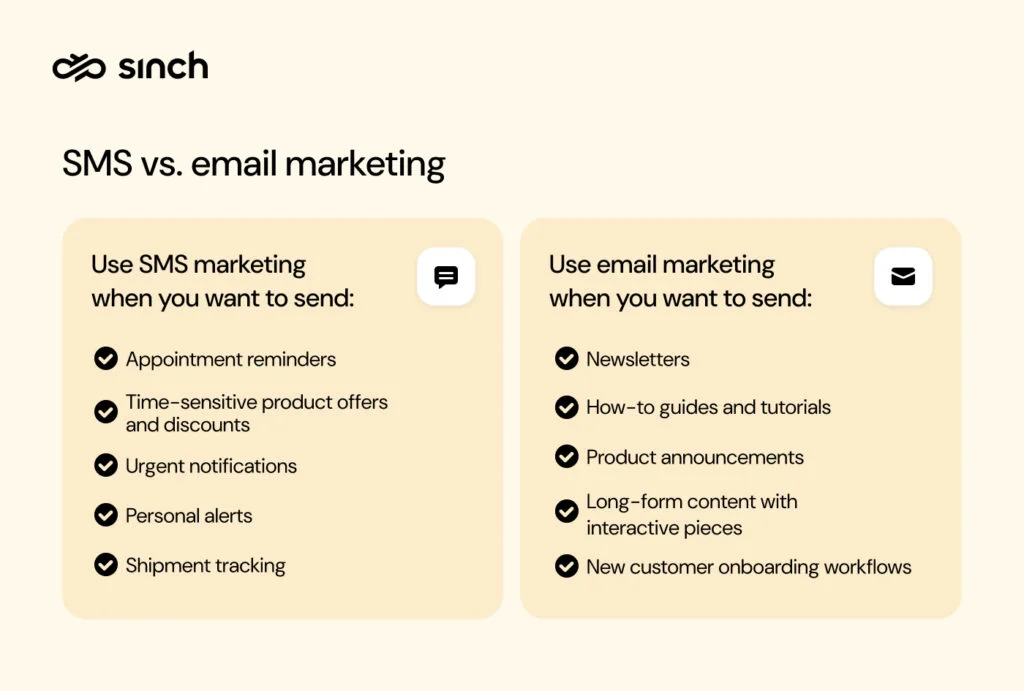Insights
SMS vs email marketing: Why the best marketers use both

Insights

You’ve heard the debate before: SMS vs email marketing – which works better? But in 2025, that question misses the mark. It’s not about picking a winner. It’s about building better, more responsive customer journeys that meet people where they are, whether that’s in their inbox or on their lock screen.
Each channel has its strengths. Each has limits. But together, they’re most effective when used with purpose.
That’s what the smartest marketers are doing: Shifting from a “channel vs. channel” mindset to a customer-first strategy. And now, with new data from Sinch’s 2025 State of customer communications report, based on insights from 2,800 global consumers and 1,600 business leaders, you can make these choices with clarity.
We’ll walk you through how to reframe the conversation and rethink your approach to SMS and email. This way, you’ll create seamless, strategic communications that drive results, and deliver better customer experiences every time.
The primary strengths of SMS marketing come from its super high open rates and fast response times. With a 98% average open rate, you can be sure that nearly everyone who receives your text messages will open them – most (90%) within three minutes, and SMS consistently generates over 10% click through rates.
That said, SMS marketing is all about timing and relevance. Overdo it, and people will unsubscribe fast. Send messages at the wrong moment (like the middle of the night), and you risk damaging trust.
Email marketing, on the other hand, is like the marathoner of marketing channels. It may not always win on immediacy, but it drives long-term loyalty and can result in pretty strong customer engagement. Organizations that segment their emails see a 30% open rate boost and 50% higher click through rate. With personalization, the metrics get even better.
On the downside, there can be hurdles with deliverability challenges (though this can be largely overcome with email deliverability optimization). And SMS messages often win for real-time urgency.
Here’s a quick side-by-side to help you compare.
| SMS | ||
|---|---|---|
| Open rates | 98% | Between 15-20% |
| Click through rate (CTR) | Around 10% | 2-5% |
| Affordability | Fairly cheap | Cheap, especially for large volumes |
| ROI | High | High |
| Reliability | Seldom goes to spam | Susceptible to spam filters |
| Reach | Mobile phone users | Accessible on various devices and platforms |
| Response rates | 40-50% | 4-6% |
| Character limit | Limited to 160 characters | No limit – can be short or long |
| Capabilities | Send written text only | Send text, images, videos, forms, links, social media buttons, and so much more |
The bottom line: Both marketing channels are cost-effective compared to most other options, so there’s usually a low barrier to using both channels in your marketing efforts. Both can utilize automation to reduce the amount of work required, and both offer relatively easy methods for measuring engagement rates.
When considering SMS vs email marketing, it’s not about which one is better. These days, marketers are shifting their perspective and strategies to choose the right channel for the right job.
Start by looking at your current approach:
And then, as yourself these key questions:
Here’s the general rule of thumb:
In fact, 75.4% of consumers expect transaction messages within five minutes, according to the 2025 State of customer communications report. While email can meet that speed, SMS messages are more likely to be seen instantly, and be perceived as faster, too.
This is why the most effective strategy uses both SMS and email marketing messages. Trying to use just one channel to do everything means it will struggle to deliver results in areas where the other channel performs better.
There’s a better way to choose your communication channel: Start with the customer.
Ask yourself: Which channel will make this message land best? How can we deliver it in a way that makes the customer feel seen, valued, and understood?
Too often, companies will default to more email messages. But more doesn’t always mean better. In fact, 48% of consumers in the State of customer communications report say they’re overwhelmed by too many emails.
This happens because too often marketers are playing the odds, assuming that if they send the same message three times over three days, at least one will get opened. It makes sense, but there’s a better way.
Instead of flooding inboxes, think: Would this message get more traction if I paired one email with a well-timed text message? If visibility is the goal, using SMS can close the loop.
And consumers are telling us that they want:
That last point is important because of rising phishing attempts, where even your real emails can look shady. Transactional emails like order confirmations and shipping notices are especially vulnerable.
So in the end, it’s not about more messages, but the right message, in the right channel, at the right time. Let that guide your strategy.
Email marketing campaigns perform very well when it comes to delivering deeper content, loyalty-building, and long-form messaging. But where it struggles, SMS marketing campaigns can step in and get the job done.
Take deliverability as an example. Many businesses struggle with email deliverability – messages that get lost in spam filters, tucked into Promotions tabs, or blocked entirely. That’s a major issue if your message needs to be seen. And nearly 40% of businesses say their email tools aren’t well integrated with their CRM, which can limit personalization.
Now, compare that to SMS, which has very high deliverability and immediate visibility, especially for time-sensitive promotions, appointment reminders, and transactional updates.
But, text messages don’t work as well for:
For that, email marketing is far superior, and this is true compared to MMS as well. Though MMS allows for graphics and other types of digital content, the formatting limitations don’t allow for as clean or effective a presentation as email marketing can provide.

And that is why high-performing marketing teams use both email and SMS messages strategically. When you align them based on channels strengths and customer context, you deliver messages that are:
Here’s a list of common scenarios where you need to decide which communication channel (or combination) typically performs best, backed by data from the 2025 State of customer communications report.
| Scenario | Best channel |
|---|---|
| Appointment reminders | SMS |
| Time-sensitive offers/flash sales | Both |
| Urgent notifications | SMS |
| Order or shipping details | Both |
| Requested messages | Both |
| Newsletters | |
| How-to content | |
| Long form or interactive content | |
| Welcome content for new customers | |
| Security/verification | Both |
| Customer feedback | Both |
One big insight from the data: Consumers want choice. Many prefer important updates to arrive through both SMS and email, or want to select their own preferred channel.
That preference becomes even more important when it comes to personalized messages. Whether you’re sending a follow-up after a purchase or a proactive reminder about an appointment, using the right channel will show your target audience that you’re listening to them, and value their preferences.
By now it’s probably clear that SMS and email are stronger together. But how do you actually combine these marketing channels in a way that’s strategic rather than spammy? Here’s where to start.
The golden rule of SMS and email marketing: Get consent. The second rule: Get consent. Yes, it’s that important, both for legal reasons and for the customer experience.
Email compliance standards have tightened over the past decade and SMS compliance is even more strict. Regulations like the Telephone Consumer Protection Act (TCPA) for SMS and laws like the GDPR and CAN-SPAM for email spell out what companies must do when marketing to customers.
Opt-in isn’t just about legal compliance, either. According to our 2025 survey data, 58% of consumers want to choose their preferred communication channel during registration. So make sure that when they hand over their email or phone number, you’re collecting their consent to message them. Let them decide, and deliver value in return.
“When you’re collecting opt-in, be upfront about what people are going to be receiving. If you get creative with the messages that you’re sending out, then you won’t be perceived as spammy. Think about sending out something that you would want to receive.”

Your customers want relevant, personalized messages. When you segment your email and SMS lists, you can make headway with both. One form of segmentation is to give people the option of which channel they prefer to use for receiving their updates. This is segmentation by channel – give people what they want, where they want it.
Think of SMS and email as two parts of the same conversation:
For subscribers on both lists, pick the best-fit channel for the message. Or use both in a coordinated sequence – email to explain, SMS to prompt action. That’s the beginning of an omnichannel marketing strategy, an approach that will reward you with higher engagement, a greater conversion rate, and more revenue.
Customers may first prefer that you use email or SMS, or another channel such as instant messaging on social media. But, their preferences may change. By having other tools in your communication strategy such as RCS and MMS, you can engage customers on their mobile devices in an ever-growing variety of methods, so they always interact with you in the manner most effective at that time.
What this all comes down to is this: You want to optimize your marketing communications for each subscriber to deliver the best customer experience possible in all scenarios.
Yes, that’s a lofty goal. But great marketing isn’t channel-first, it’s customer first. And by continually improving and optimizing your strategy, you’ll always be using email and text message marketing in the most effective ways. Each has their strengths, and if you use them accordingly, you’ll have better engagement, more customer satisfaction, and fewer complaints and silent frustrations.
Email and SMS are not competing. They complement each other and work well as part of your overall omnichannel marketing strategy.
Check out the complete State of customer communications report for more insights about how customers and companies communicate and interact. Or talk to our team about how we help enterprise brands unify their communications strategy at scale.